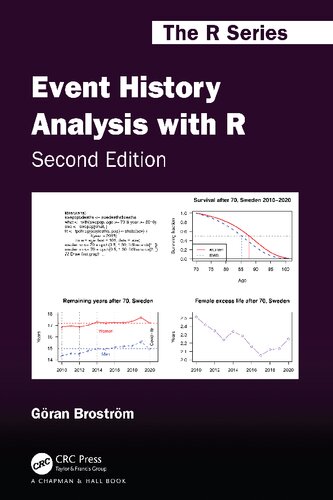

Most ebook files are in PDF format, so you can easily read them using various software such as Foxit Reader or directly on the Google Chrome browser.
Some ebook files are released by publishers in other formats such as .awz, .mobi, .epub, .fb2, etc. You may need to install specific software to read these formats on mobile/PC, such as Calibre.
Please read the tutorial at this link. https://ebooknice.com/page/post?id=faq
We offer FREE conversion to the popular formats you request; however, this may take some time. Therefore, right after payment, please email us, and we will try to provide the service as quickly as possible.
For some exceptional file formats or broken links (if any), please refrain from opening any disputes. Instead, email us first, and we will try to assist within a maximum of 6 hours.
EbookNice Team

Status:
Available4.6
11 reviewsWith an emphasis on social science applications, Event History Analysis with R, Second Edition, presents an introduction to survival and event history analysis using real-life examples. Since publication of the first edition, focus in the field has gradually shifted towards the analysis of large and complex datasets. This has led to new ways of tabulating and analysing tabulated data with the same precision and power as that of an analysis of the full data set. Tabulation also makes it possible to share sensitive data with others without violating integrity.
The new edition extends on the content of the first by both improving on already given methods and introducing new methods. There are two new chapters, Explanatory Variables and Regression, and Register- Based Survival Data Models. The book has been restructured to improve the flow, and there are significant updates to the computing in the supporting R package.
Features
• Introduction to survival and event history analysis and how to solve problems with incomplete data
using Cox regression.
• Parametric proportional hazards models, including the Weibull, Exponential, Extreme Value, and
Gompertz distributions.
• Parametric accelerated failure time models with the Lognormal, Loglogistic, Gompertz, Exponential,
Extreme Value, and Weibull distributions.
• Proportional hazards models for occurrence/exposure data, useful with tabular and register based data,
often with a huge amount of observed events.
• Special treatments of external communal covariates, selections from the Lexis diagram, and creating
period as well as cohort statistics.
• “Weird bootstrap” sampling suitable for Cox regression with small to medium-sized data sets.
• Supported by an R package (https://CRAN.R-project.org/package=eha), including code and data for
most examples in the book.
• A dedicated home page for the book at http://ehar.se/r/ehar2
This substantial update to this popular book remains an excellent resource for researchers and practitioners
of applied event history analysis and survival analysis. It can be used as a text for a course for graduate
students or for self-study.